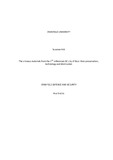JavaScript is disabled for your browser. Some features of this site may not work without it.
| dc.contributor.advisor | Shortland, Andrew J. | |
| dc.contributor.advisor | Valsami-Jones, E. | |
| dc.contributor.author | Kirk, Susanna | |
| dc.date.accessioned | 2011-09-07T10:48:34Z | |
| dc.date.available | 2011-09-07T10:48:34Z | |
| dc.date.issued | 2011-09-07 | |
| dc.identifier.uri | http://dspace.lib.cranfield.ac.uk/handle/1826/5825 | |
| dc.description.abstract | This project presents the first large-scale study of the preservation and alteration of Late Bronze Age vitreous materials from the Near East. An understanding of the processes that affect buried glasses is of importance both in the conservation of ancient artefacts and as analogues for the disposal of vitrified nuclear waste. This project has focused on the vitreous material from Nuzi, a mid 2nd millennium BC site in Iraq, held at the Semitic Museum at Harvard University. This is one of the largest assemblages of vitreous material known from the Late Bronze Age, containing a wide range of objects. A survey was made of the assemblage and the distribution of vitreous materials across the site was established. It was found that the majority of these materials are associated with high-status and religious areas of the city. Over 150 samples of vitreous material, including 90 LBA glasses, were characterised in detail, using a variety of analytical techniques including, SEM-EDS, SEM-WDS, LA-ICPMS and XRD. Compositional analysis suggested that the antimony-opacified glasses may have been manufactured at a higher temperature than the translucent glasses; supported by a series of experiments replicating the opaque glasses. The results also showed that the alteration of the glasses was highly variable, both in the degree of alteration and the composition and morphology of the alteration layers. This variability could not be correlated with the original location of the objects on the site, including objects from the same room, and it was concluded that small microenvironmental changes were responsible for producing the large range of variation seen. In addition, a distinction was noted between the alteration of translucent and opaque glasses, which was found to be repeated in the dissolution experiments with the opaque glass having a much higher dissolution rate. The alteration experiments have established a dissolution rate for LBA composition glasses and indicated that replica glasses are a good analogue for archaeological glasses of the same type. It is suggested that the dependence on the burial environment of archaeological glasses, an open system, compared to the closed system of nuclear waste glasses means that the use of data from archaeological glasses in looking at the effects of long-term burial on nuclear waste glasses has to be carefully applied. | en_UK |
| dc.title | The vitreous materials from the 2nd millenium BC city of Nuzi : their preservation, technology and distribution | en_UK |
| dc.type | Thesis or dissertation | en_UK |
| dc.type.qualificationlevel | Doctoral | en_UK |
| dc.type.qualificationname | PhD | en_UK |
